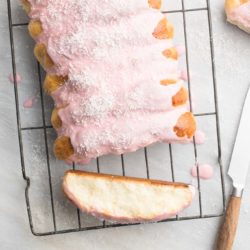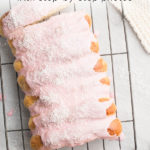Iced Finger Buns

- Resting Time: 2 hours
- Prep Time: 1 hour
- Cook Time: 30 mins
- Total Time: 3 hours 30 minutes
- Yield: Makes 16
- Category: Bread
- Method: Oven
- Cuisine: Australian
Soft and fluffy Iced Finger Buns (or Iced Buns), a classic Australian bakery treat! Easy recipe with step-by-step photos.
Ingredients
For the Finger Buns
- 600 g (4 cups) white bread flour
- 110 g (1/2 cup) caster sugar
- 1 teaspoon fine salt
- 14 g (4 teaspoons) instant dried yeast (see Kitchen Notes below)
- 375 ml (1 1/2 cups) milk, warmed to 37°C (98°F)
- 60 g (4 tablespoons) butter, softened
- 40 g (1/4 cup) sultanas or raisins (or more, to taste)
For the Egg Wash
- 1 egg, lightly beaten
- 1 tablespoon milk
For the Icing
- 320 g (2 cups) icing sugar (powdered sugar)
- 1–2 tablespoons milk
- pink food colouring (optional)
- dessicated coconut
Instructions
You will need approx. 3.5 hours to make the Finger Buns, un-iced.
To Make the Dough
- Measure the flour, sugar, salt and yeast into the bowl of an electric stand mixer.
- Lightly mix the ingredients together using the dough hook.
- Slowly pour in the warm milk, and continue mixing until everything comes together into a rough dough.
- Add the butter, one tablespoon at a time. Once the butter has been fully incorporated into the dough, add the next tablespoon of butter.
- Once all of the butter has been added, continue kneading the dough on medium speed for about 15 to 20 minutes.
- The dough is ready when it is soft and smooth, and also slightly elastic in texture when you try to stretch it. If you poke the dough softly, it should bounce back right away.
For the First Proofing Session
- Lightly oil a large mixing bowl.
- Place the dough inside the bowl.
- Cover the dough with a clean tea towel, cling film, or a reusable bowl cover.
- Leave the dough somewhere warm for 1 to 1.5 hours, or until the dough has doubled in size (see Kitchen Notes below).
To Shape the Dough
- Once the dough has doubled in size, gently remove the dough from the bowl. The dough will deflate as you handle it.
- Pat the dough into a round shape.
- Knead in all of the raisins.
- Portion your dough into 16 equal pieces. If you have some kitchen scales, weigh the dough and then divide this number by 16. This will be the weight of each bun dough.
- Lightly grease two rectangular pans measuring 17 cm x 27 cm (7 inch x 11 inch) or similar.
- Gently knead each ball of dough, and then roll the dough into a small log which is a bit shorter than the short length of the pan you are using. So if your pan is 17 cm (7 inches), aim to make your buns about 13 cm (5 inches) long.
For the Second Proofing Session
- Place 8 pieces of dough into each pan.
- Cover the pans with a clean tea towel, and place the pans somewhere warm for about 30 minutes, or until the buns have risen and puffed up slightly.
- Meanwhile, preheat the oven to 220°C (428°F) (without fan).
- Place a metal baking tray in the middle of the oven.
- Make the egg wash by lightly whisking together the egg and milk.
To Bake the Buns
- Brush the buns with some egg wash.
- Bake for about 25 minutes, or until the buns are lightly golden. Check the buns at about 10 minutes, and if they are browning too quickly, cover them with a loose sheet of foil for the rest of the baking time.
- The buns are cooked if an internal thermometer reads 85°C (185°F).
- Gently remove the buns (intact) to a wire rack, and leave them to cool completely.
For the Icing
- Whisk in just enough milk to the icing sugar (powdered sugar) until you have a thick but spreadable consistency.
- If you like, add some pink food colouring. Start by adding just a drop and keep adding more until you have the colour you want.
To Serve
- Leave the buns on a wire rack, but place a sheet of baking paper under the wire rack for easy cleaning.
- Use a small palette knife to spread the icing all over the (unseparated) buns.
- Sprinkle generously with dessicated coconut.
- Leave the buns for about 20 minutes to set before serving.
Kitchen Notes
 DIFFERENT TYPES OF FLOUR
DIFFERENT TYPES OF FLOUR
* This recipe works well with plain flour (all-purpose flour) or strong white bread flour.
* For Swiss readers: I use Zopfmehl (or farine pour tresse) when making bread and enriched dough.
 DIFFERENT TYPES OF YEAST
DIFFERENT TYPES OF YEAST
* Please note that there is a difference between instant yeast (also called instant dried yeast or fast-action dried yeast) and dried yeast (also called active dry yeast). If you are not sure what type of yeast you have, please check the packaging for instructions on how to use the yeast.
* With instant yeast, you can add it directly to the flour mixture without having to activate it first.
* With dried yeast, you will need to activate it first (usually in some warm liquid).
* If you are using fresh yeast, you will need about one block (40 g fresh yeast = 14 g instant dried yeast). Crumble the fresh yeast into the warm milk, and stir to dissolve the yeast.
 PROOFING THE DOUGH
PROOFING THE DOUGH
Dough needs a warm environment for the yeast to activate and cause the dough to rise. If you don’t have a warm place in your home, try one of the following ideas:
* In the oven with the oven light switched on (works only for some ovens).
* In the oven with a tray of boiling water on the bottom shelf.
* In the oven or a steamer oven at a low temperature of about 25-40°C (77-104°F).
 OVEN & STOVE TEMPERATURES
OVEN & STOVE TEMPERATURES
All recipes on this website have been tested on an induction stove and/or with a conventional oven (i.e. an oven without fan). All recipes on this website use temperatures for a conventional oven, unless otherwise mentioned. Convection ovens (i.e. fan-forced ovens) are typically 20°C/70°F hotter than conventional ovens, but please check your manufacturer’s handbook.
 CONVERSIONS
CONVERSIONS
To convert from cups to grams, and vice-versa, please see this handy Conversion Chart for Basic Ingredients.
View the recipe online: https://eatlittlebird.com/iced-finger-buns/

